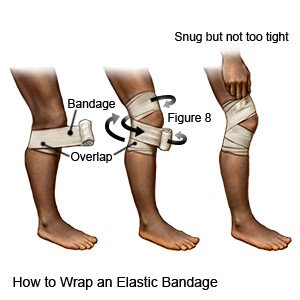Leg Sprain
Medically reviewed by Drugs.com. Last updated on Apr 6, 2025.
A leg sprain is an injury that occurs when your ligaments are forced to stretch beyond their normal range. Ligaments are tough tissues that support joints, and connect and keep bones in place. Mild sprains may take up to 6 weeks to heal. Severe sprains can take up to 12 months to heal.
DISCHARGE INSTRUCTIONS:
Return to the emergency department if:
- You have severe pain that does not go away.
- Red streaks appear near your injury.
- You have numbness or a loss of movement in your injured leg.
Call your doctor if:
- Your pain or swelling worsens, or does not improve with treatment.
- You have a fever, redness, swelling, or warmth around your injury.
- You have questions or concerns about your condition or care.
Medicines:
You may need any of the following:
- Acetaminophen decreases pain and fever. It is available without a doctor's order. Ask how much to take and how often to take it. Follow directions. Read the labels of all other medicines you are using to see if they also contain acetaminophen, or ask your doctor or pharmacist. Acetaminophen can cause liver damage if not taken correctly.
- NSAIDs , such as ibuprofen, help decrease swelling, pain, and fever. This medicine is available with or without a doctor's order. NSAIDs can cause stomach bleeding or kidney problems in certain people. If you take blood thinner medicine, always ask if NSAIDs are safe for you. Always read the medicine label and follow directions. Do not give these medicines to children younger than 6 months without direction from a healthcare provider.
- Take your medicine as directed. Contact your healthcare provider if you think your medicine is not helping or if you have side effects. Tell your provider if you are allergic to any medicine. Keep a list of the medicines, vitamins, and herbs you take. Include the amounts, and when and why you take them. Bring the list or the pill bottles to follow-up visits. Carry your medicine list with you in case of an emergency.
Self-care:
- Rest your leg for up to 2 days to help it heal. Return to normal activities as directed.
- Ice your injured leg. This helps decrease swelling and pain, and may also help prevent tissue damage. Use an ice pack, or put crushed ice in a plastic bag. Cover the ice pack with a towel and place it on your injury for 20 to 30 minutes, up to 4 times daily. Use the ice for as long as directed.
- Compress your injured leg with an elastic bandage as directed. An elastic bandage provides support and helps decrease swelling and movement so your joint can heal. You may need a cast or splint if your injury is severe.

- Elevate your injured leg by lying down and resting it on pillows that are higher than your heart. This should be done as often as you can for at least 2 days to reduce swelling.

Activity:
Ask your healthcare provider how much activity is right for you. Start activity slowly and stop if you feel pain. Your healthcare provider may suggest the following:
- Exercise may help reduce stiffness in your leg. Your healthcare provider may show you certain exercises that you can do on your own.
- Physical therapy will teach you exercises to help improve movement and strength, and to decrease pain.
Prevent another leg sprain:
- Warm up, cool down, and stretch before and after you exercise. This may help ease your body into activity, and prevent another injury.
- Wear protective equipment for activities. This will prevent another injury.
- Wear shoes that fit well. Replace your shoes when the tread or heels are worn down.
- Do not exercise when you are tired or in pain. You are more likely to become injured if your body is not rested.
- Make the places you walk safer. Keep your pathways clear of objects so you do not trip over them. Pour salt on driveways and walkways in the winter to help prevent you from slipping on ice.
- Run and walk on flat surfaces. Bumpy or curvy paths put you at risk for another injury.
Follow up with your doctor as directed:
Write down your questions so you remember to ask them during your visits.
© Copyright Merative 2025 Information is for End User's use only and may not be sold, redistributed or otherwise used for commercial purposes.
The above information is an educational aid only. It is not intended as medical advice for individual conditions or treatments. Talk to your doctor, nurse or pharmacist before following any medical regimen to see if it is safe and effective for you.
Learn more about Leg Sprain
Care guides
Further information
Always consult your healthcare provider to ensure the information displayed on this page applies to your personal circumstances.
